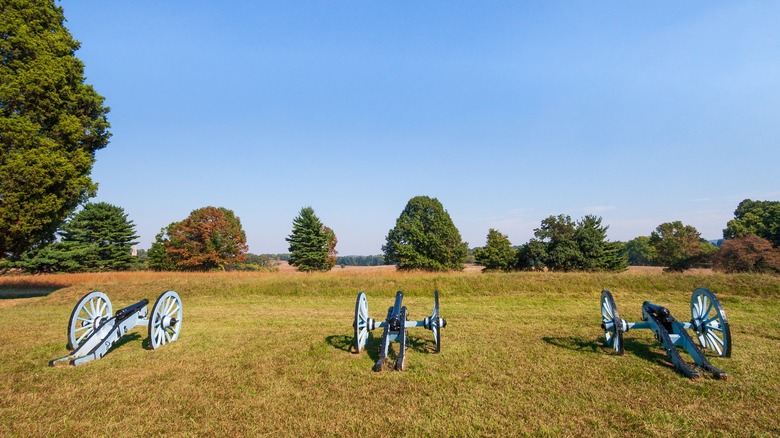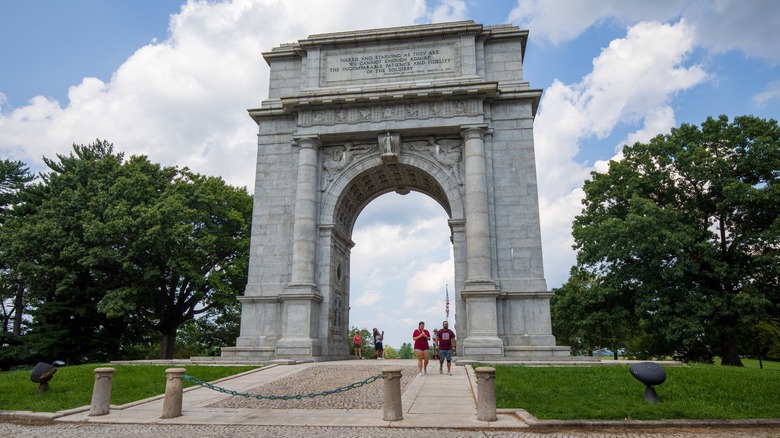Pennsylvania's Riverside Park Is A Revolutionary-Era Escape With Rolling Meadows And Trails
If you want to engorge yourself on early revolutionary American history, head to the city where the Declaration of Independence was signed. Philadelphia, with its rich history, is one of America's top travel destinations, with some of the most important sites of America's path to independence. Several (like the Liberty Bell) are concentrated in the Old City, called "America's most historic square mile." But there's another angle to the fight for American independence captured in a quieter corner of the metro area, about 20 miles from the city center, at Valley Forge National Historical Park. The park, today a serene landscape with hilly picnic areas and trails along the Schuylkill River, was once where George Washington and his Continental Army endured a difficult winter during a crucial stage of the American Revolution.
Philadelphia was the crux of the Revolutionary War, and Valley Forge National Historical Park is one of nearly three dozen sites on the city's American Revolution Trail. While Valley Forge may not have the prestige of other sites on the trail like Independence Hall, it's an essential stop for anyone who wants to trace the footsteps of Washington's troops or just enjoy some nature outside of the hubbub with a historical flair. No battle took place here, but the encampment that once spread out here under a harsh, long winter was a test of the Continental Army's endurance, making them better trained and more determined when they came out on the other side. Today, curated trails lead you through the former encampment, with reconstructed huts and fortifications, rich with details as immersive as a reproduction bake oven and rangers dressed in period-accurate garb.
What happened at Valley Forge National Historical Park?
When George Washington and his army arrived at Valley Forge in December of 1777, they had just lost several battles in an attempt to defend Philadelphia against British occupation. This would be their home for the next six months, with minimal supplies, a lack of shelter, and biting weather conditions. The 3,600-acre plateau of the encampment was muddy and cold, but it was a crucial site for maintaining a defensive position over Philadelphia while remaining far enough to avoid ambush. One of the biggest challenges (in addition to disease) was a lack of food, clothing, and shelter, but the soldiers set to work on building log huts and even putting together makeshift clothes.
Over 12,000 men of the army, plus 400 women and children (including Martha Washington), populated Valley Forge at its inception. Around 1,500 huts were built across two miles of fortification. They also built five earthen forts and a Roman-style bridge that crossed the Schuylkill River. During those six months of encampment, Washington assigned the Prussian officer Baron von Steuben to train the soldiers. The army also gained the alliance of France at that time. These developments left the army better equipped, unified, and determined to take on future battles. However, the encampment was not without its losses — over 2,000 of those stationed at Valley Forge died from various diseases and food shortages.
How to visit Valley Forge National Historical Park
From the Philadelphia International Airport, Valley Forge Historical Park is a 35- to 40-minute drive away. It's also easy to reach from Center City in about 45 minutes, so you can fit in other local historic sites, like Elfreth's Alley, America's oldest residential street, on a trip through the city. The park grounds are open daily from 7 a.m. to sunset, though certain buildings (like Washington's Headquarters) have more limited hours, and you don't need to pay an entry fee. There's a visitor center that's worth starting at, since it serves as both a hub for park information and a museum with immersive exhibits about the conditions of the encampment.
A good way to get a full picture of the park's layout and sites is along the 5-mile Joseph Plumb Martin Trail. It's paved and traces the park's inner loop, connecting sites like the National Memorial Arch, the Patriots of African Descent Monument, and Muhlenberg's Brigade, where you can walk along an assembly of reconstructed huts. If you don't want to do the full loop, a 0.75-mile abbreviated version of the trail takes you from the visitor's center to Muhlenberg's Brigade and back along one of the redoubts (an earthen fortification) — you won't want to miss the brigade, as this is a great way to get a sense of what life was like in the camp, with volunteers dressed in 18th-century uniforms to demonstrate how the camp inhabitants lived and trained. There are also several trails that wind along the river, through woods and meadows, for a quieter stroll.


